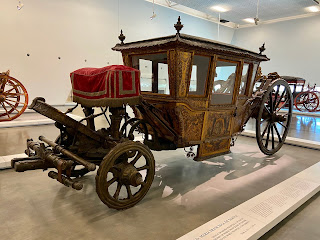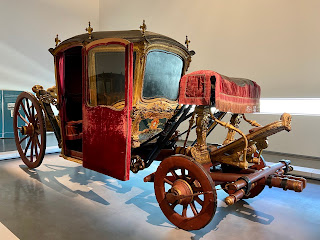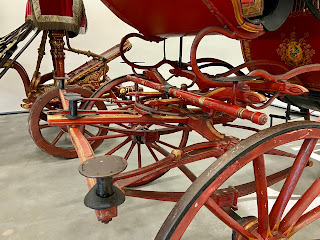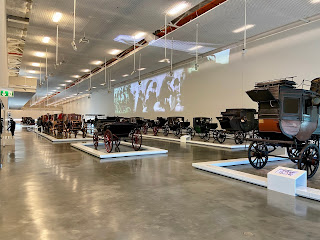The Museu Nacional dos Coches is a museum of coaches - royal coaches, hyper-ornamented wagons. But it's not what you think. In pictures that I had seen online, the Museu did not look inviting – dark, the vehicles lined-up and roped-off, little placards on stands. Plus, it's about coaches.
I should know better, because I spent some time working at the Larz Anderson Auto Museum. The Anderson Collection so effectively tells the story of the invention and development of the automobile during the early 1900's. The Museu's A Coleção tells the preceding chapter: how the coach developed during the 1500's, all the way through the 1800's. Of course, this also mirrors Portugal's rise during the Age of Discovery, and all the growth in technology that enabled that exploration.
First, the facilities are astounding – two football-field length galleries, clean, well-lit, and full of interactive technology. This new building opened at the end of 2015, lept over all those missing centuries, and gives these old coaches the best home imaginable. No annoying ropes, the coaches are protected by a frame on the floor, so you can walk around and see every level. I wonder if the old place, the Picadeiro Real, was even air conditioned. The website is informative and complete. There are touch-screen media panels, too. Yes, there's even an app. If only Larz Anderson could be nationally funded.
South Gallery
The first coach, Coche de Filipe II, is a big brute – given that this is a royal brute, it has a certain level of ornament and luxury, but the technology is basic. It is a studded leather box with facing velvet benches; two additional benches hang rather precariously, over the running boards (a pair of uncomfortable-looking spikes at either end). Some wooden windows are hung with belts to provide an enclosure. The most impressive feature of this coach is the interior ribbing for the roof, which is really impressive: a golden burst of blossoms and sunbeams set against the deep velvet.
The engineering is strait-forward. Two long 'logs', bound to each other between the axels, act as a central spine to carry the weight and motion. Atop this, a substantial wood frame holds the whole thing together. There's no real steering mechanism, as the coach is driven by riders on the horses (postillions). The wheels are covered with iron straps and round-head fasteners, which probably says something about the road technology of the 16th century.
The passenger compartment is held in place by a system of leather belts held up by wooden yokes at each end of the chassis. It all looks fairly questionable, but it is the coach of a king, Filipe II – who ruled both Spain and Portugal, so this coach is Spanish.
Nearby wall cases fill in some details: spare wheels, an old jack stand, some seriously heavy-duty boots (for safety near the wheels), olive-oil torches carried by attendants, and a long shaft (tongue?) that would be rigged beside the first pair of horses. The coach does not have brakes, so the first pair of horses (the wheelers) provide the braking, which requires a rigid connection to the coach.
Though the 17th century, the architecture of the coaches remains fairly standard, but the ornament begins to spill out in incredible abundance. The subsequent coach is a gift from Louis XIV of France, to his cousin, Dona Maria Francisca de Sabóia, for her marriage to rei Dom Afonso VI, in 1666. So this ceremonial coach, like the queen, is French.
As I'm trying to take a picture of the painted rear panel, I realize that the undercarriage is fascinating. A curving, laminated central beam again carries the weight. At the rear, additional pieces are laminated and protrude out the back; I assume this is where the footmen travel. The rigid, S-shaped braces may allow some give for the suspension system as well as space for the attendants. The yoke, now highly decorated, holds a slightly more elaborate system of leather straps, which seem go under the passengers and to the front.
Another French coach belonging to D. Maria Francisca de Sabóia is, I suppose, more of a 'daily driver'. Larger, but with the same type of engineering, the front suspension includes a simple, circular steering mechanism with an additional vertical axel, called a 'fifth wheel'. The connection linking this steering truck and the central beam is accomplished with a pair of hoops known as the 'swan's neck'; the offset, I surmise, allows the wheels to turn more sharply while keeping the center of gravity low. The truck and 'swan's neck' are visible on all the coaches of this era. The coachman (driver) can now sit on the lovely velvet bench provided on the vehicle.
The neighboring carriage is, finally, from Portugal, 18th century, and is the ceremonial coach of D. João V. On this one, every inch is covered in sculpture, bronze trim, and paint. Even the front edge of the coachman's footboard is slathered with smiling women and gaping animals. Between the nude female figures, you can see a more intricate system of leaf springs joining the belts and the coachwork.
The next is Austrian (or possibly Dutch), and belongs to D. Maria Ana de Áustria, wife of D. João V. The decoration is all in textured relief, gilt woodwork, with a painted panel at the back (Minerva being crowned). The rear-facing sculpture is a cascade of (clothed) female figures holding the crown over the queen's monogram. At the front are more scary beasts to encourage the horse team on. And, again, the suspension springs are hidden among the lions and reclining figures.
At the back of the Coche da Coroação de Lisboa, a female figure of Lisboa is being crowned by two attendants, one holding a cornucopia and the other a clarion, with a sea serpent snapping at their feet. Two lowly male figures, evidently representing Africa and Asia are trailing the group (thanks a lot Lisboa). Above all of them, two putti are hanging on for dear life.
At the back of the Coche dos Oceanos, a central male figure, holding a harp and kneeling on a globe, is attended by two females, one holding a bundle of wheat the other a bouquet of roses. Trailing them are two bearded gentlemen, shaking hands, evidently to symbolize the joining of the Atlantic and Indian Oceans. I'm not sure the globe is an accurate representation of those Oceans – made by Italians, of course, not Portuguese.
Playing above these 'triumphal coaches' is a cinema-scaled media piece, making great use of the empty wall space, and showing how the coaches looked in motion and on parade, etc. Accompanied by period-correct classical music, it ties things together and helps the coaches tell their stories.
The last coach in this first gallery is the Coche da Mesa, the Table Coach. This is Portuguese, with a wide, octagonal body, and somewhat less ornament – by comparison to its neighbors. It looks rather utilitarian, though it is trimmed in gold and velvet, but the wheels aren't even decorated. It is designed for a longer trip to the Spanish border, for the Troca de Princesas in 1729 - the Exchange of the Princesses.
As I walk the gallery, I appreciate the way the Museu utilizes the new building, but two useful things seem to be missing. Thinking out loud, I propose that one coach be rigged with a team of horses so we could see the full scale of a complete turnout (or it could be printed on the wall), with a call-out for all the parts. The other thing I might suggest is to illuminate the interiors of one or two of the coaches, as it's really hard to see.
Coming close to my second wish, the door to this Coche da Mesa is open, and we can easily see inside with help from the nearby ribbon windows. As the title suggests, there is a wonderful, round table with a well-weighted pedestal base. We imagine the princesses spilling a lot of tea as they are driven to their new husbands, or writing a few sloppy letters.
North Gallery
The next hall begins to illustrate some real innovation, for example, the Berlinda da Casa Real. A 'Berlin' is a German invention (those Germans!) from the late 1600's, and this is a French coach from the late 1700's – we understand these ideas were traded between countries much like princesses. The body looks much the same, but the chassis is formed by a pair of bowed through-beams set on either side, with a ratchet suspension system, called a cric, to tighten the strapping. It is simpler, lighter, faster, and evidently more comfortable for the passengers.
Down a few places is the Carruagem de Gala, a ceremonial coach built for the Patriarchs of Lisbon. So clean and simple, it is 19th century Portuguese. The body sits between ultra-light rails, which are suspended on elliptical leaf springs at each corner. The spokes of the wheels tell you this is efficient construction. There is also a brake pad operated by a crank above the driver's seat. This may suggest that a simpler harness is employed which eliminates the rigid shaft. On the downhill, the driver simply turns the crank to keep the carriage from rolling into the horses.
Then we have theme and lots of variation. The Berlinda da Cama is extra-long bodied and, we are told, there are beds inside for long trips as well as a sistema de evacuação (the Anderson Collection has a 1906 CVG with a toilet, too). The Berlinda da D. Maria I has fairly strait beams, so it's a simpler structure and rides much higher. Because of the lighter construction there may be less concern for its higher center of gravity. Compare this 'daily driver' to the one used by D. Maria Francisca de Sabóia one hundred years earlier.
The vehicles seem to shrink into the distance, except in this case, they really are shrinking. At the same time, they exhibit remarkable variety: two-wheeled chaises, carriages for kids, litters drawn by mules, sedan chairs carried by footmen. Several of the vehicles have lanterns mounted, allowing for easier travel any time of day, and some have fenders for foul-weather journeys. We consider all the varieties needed to move all classes of people, doing chores, shopping, and paying calls.
Now the Museu fulfills another wish with a full-scale, fully-rigged team and coach. It is not printed, and it is magnificent. The Carruagem da Coroa is a British-built state carriage from 1824 and really looks the part of a state carriage – clean shapes and lines, tasteful amounts of gold here and there, the marvelous velvet bench cover, proud eagles at the doors, and a royal crown on top.
Thoughtfully in the nearby wall displays, the coachman and other servants await. In another case are the harnesses and hardware. I admire the sliding glass doors on these displays, too, with the modern door hardware and 'English-style' coach hardware in juxtaposition.
The wheels have thick rubber bands over the iron straps, possibly indicating improved roads (some of the other nearby coaches also have rubber on their wheels). There are substantial, cylindrical lanterns mounted at each corner, adorned with gold swags and crowns. The coachman sits above roof-level and can see over the team, down the road. The curving lines of the suspension mounts and the shaped beams underneath the bodywork lend the coach a flowing quality. A pair of serpents trail behind like exhaust pipes.
The group across from the Carruagem da Coroa shows the variation in bodywork. The Landau de D. Pedro V has a two-piece, folding leather hood, and a suspension system that floats the passenger compartment above the chassis. The Carruagem de D. Maria II seems clean and compact, and incorporates a set of pincer springs at the front. These two British coaches date from 1834.
There are a few examples of a body-style known as a 'Clarence', which seems to integrate the chassis with the bodywork. The lower edge swoops downward to the entry and footwell, hinting at modern-looking wheel arches. The first, more simple specimen is 19th century French, and shows basic body-shape, with elliptical springs front and back, as well as rounded corner window glass. The second Portuguese example, with the monogram of D. Perdo V, features gothic windows and twisted snakes under the floorboard.
The image below is of the Carruagem de Porto Covo, and highlights the curvilinear forms where the 'tailgunner' sits. The last two coaches are for freight and postal work. The all-dark-green Mala-posta looks like Mad Max's mail-truck, with heavy-duty leaf springs, and footholds all over the body (eight passengers ride on top). I particularly enjoy the two big brass lanterns on each side, with the smaller three-eyed signal lantern fixed to the footboard, like a murder hornet. The last black-over-red Mala-posta has two compartments connected together, perhaps for first class and economy on the Lisboa-e-o-Porto run. I notice the rear-facing door with folding stair, and think of an old school bus.
Center Gallery
A small show room connects the two hangar-like galleries, and inside is a 1895 Panhard et Levassor automobile. This is the first car ever driven in Portugal. On the wall is a catalog which identifies this as the Voiture a quatre places, forme Phaëton. The information on the museum label says:
1300cc petrol engine, 2-cylinder V-engine and 3 horsepower at 750 rotation per minute. The gearbox has 3 speeds forward and reverse … and the car could reach a speed of 26 km per hour.
So, the Daimler engine replaces three horses; fun to consider while just a few feet from a team of six horses. In outstanding condition, it looks like it still runs, because it definitely drips oil (note the towel). Such a clean, compact shape, beautiful brass fittings, and an intriguing perforated tin-can cooling system. There are no cherubs or crowns here, no mud-flap girls or truck nuts either.
UPDATE / WEDNESDAY: Over seventeen million cases now; one million new cases every four or five days. The US passed one hundred and fifty thousand deaths. Portugal overtook fifty thousand cases a few days ago.
cases: 17,135.016 global • 4,551,506 USA • 50,613 Portugal
deaths: 668,427 global • 153,477 USA • 1,725 Portugal


























































